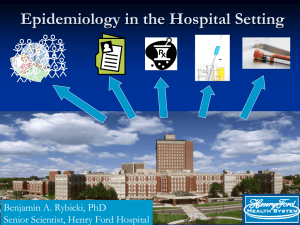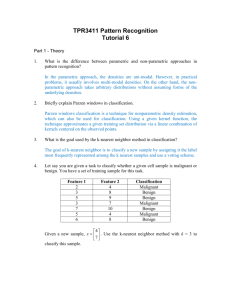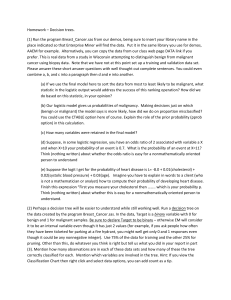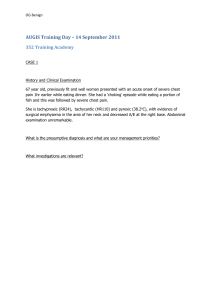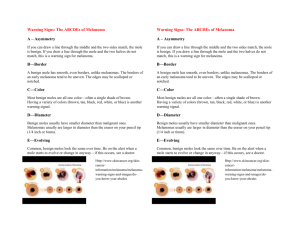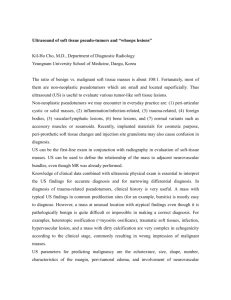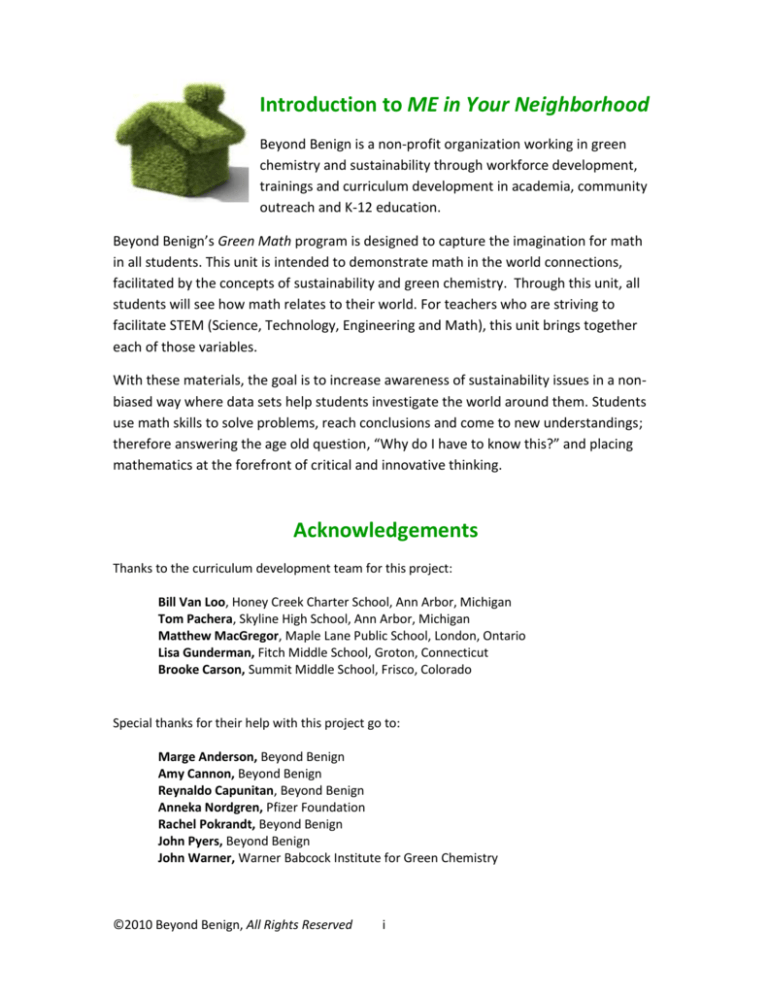
Introduction to ME in Your Neighborhood
Beyond Benign is a non-profit organization working in green
chemistry and sustainability through workforce development,
trainings and curriculum development in academia, community
outreach and K-12 education.
Beyond Benign’s Green Math program is designed to capture the imagination for math
in all students. This unit is intended to demonstrate math in the world connections,
facilitated by the concepts of sustainability and green chemistry. Through this unit, all
students will see how math relates to their world. For teachers who are striving to
facilitate STEM (Science, Technology, Engineering and Math), this unit brings together
each of those variables.
With these materials, the goal is to increase awareness of sustainability issues in a nonbiased way where data sets help students investigate the world around them. Students
use math skills to solve problems, reach conclusions and come to new understandings;
therefore answering the age old question, “Why do I have to know this?” and placing
mathematics at the forefront of critical and innovative thinking.
Acknowledgements
Thanks to the curriculum development team for this project:
Bill Van Loo, Honey Creek Charter School, Ann Arbor, Michigan
Tom Pachera, Skyline High School, Ann Arbor, Michigan
Matthew MacGregor, Maple Lane Public School, London, Ontario
Lisa Gunderman, Fitch Middle School, Groton, Connecticut
Brooke Carson, Summit Middle School, Frisco, Colorado
Special thanks for their help with this project go to:
Marge Anderson, Beyond Benign
Amy Cannon, Beyond Benign
Reynaldo Capunitan, Beyond Benign
Anneka Nordgren, Pfizer Foundation
Rachel Pokrandt, Beyond Benign
John Pyers, Beyond Benign
John Warner, Warner Babcock Institute for Green Chemistry
©2010 Beyond Benign, All Rights Reserved
i
The Twelve Principles of Green Chemistry
John Warner and Paul Anastas have developed the Twelve Principles of Green Chemistry to aid
in assessing how green a chemical, reaction or a process is.
1. It is better to prevent waste than to treat or clean up waste after it is formed.
2. Synthetic methods should be designed to maximize the incorporation of all materials used in
the process into the final product.
3. Wherever practicable, synthetic methodologies should be designed to use and generate
substances that possess little or no toxicity to human health and the environment.
4. Chemical products should be designed to preserve efficacy of function while reducing toxicity.
5. The use of auxiliary substances (e.g. solvents, separation agents, etc.) should be made
unnecessary whenever possible and, innocuous when used.
6. Energy requirements should be recognized for their environmental and economic impacts and
should be minimized. Synthetic methods should be conducted at ambient temperature and
pressure.
7. A raw material feedstock should be renewable rather than depleting whenever technically
and economically practical.
8. Unnecessary derivatization (blocking group protection/deprotection, temporary modification
of physical/chemical processes) should be avoided whenever possible.
9. Catalytic reagents (as selective as possible) are superior to stoichiometric reagents.
10. Chemical products should be designed so that at the end of their function they do not
persist in the environment and break down into innocuous degradation products.
11. Analytical methodologies need to be further developed to allow for real-time in-process
monitoring and control prior to the formation of hazardous substances.
12. Substances and the form of a substance used in a chemical process should be chosen so as
to minimize the potential for chemical accidents, including releases, explosions, and fires.
©2010 Beyond Benign, All Rights Reserved
ii
Based on the 12 Principles of Green Chemistry, a similar set was developed for green
engineering.
©2010 Beyond Benign, All Rights Reserved
iii
Implementation Options
This unit can be implemented in 2 primary ways:
1.
Stand alone unit
2.
Year long project with embedded skills
Stand alone unit:
As a stand alone unit, this curriculum can be used to introduce the skills of:
fraction
decimal
percent
rounding
measurement
area
estimation
volume
scale
conversion
Year-long project:
This unit can be used to support the curriculum you are already teaching in the classroom. With
the introduction of each skill, complete the corresponding lesson. Place the papers with the
paperclip icon on top in a folder or binder to track student progress throughout the
year. Some of the papers are necessary for students to refer back to. Ultimately,
you will build a math portfolio for individual students, allowing you, the parents, and
the students to track their progress and successes throughout the year.
Create a Neighborhood to Evaluate Student Understanding
This unit provides assessment opportunities throughout the
course of the curriculum. As a final evaluation tool, you may want
to consider building a neighborhood of houses. As each student
builds his or her home to scale, he or she will need to apply
computation and geometry skills garnered in the unit.
©2010 Beyond Benign, All Rights Reserved
iv
House Model Building Options for Teachers
Foamcore or cardboard
Building with foamcore and cardboard can produce attractive, long-lasting, durable models.
Students glue their final floor plan to a piece of cardboard, cut walls out of foamcore using a
razor knife or Exacto knife, and glue them down to the cardboard “foundation”.
Advantages
Great for kinesthetic learners
Can work with technology education teachers as a cross-curricular activity
Authentic method used by architects – good real-world connections
1/4 inch scale
Kids can take models home when completed
Disadvantages
Safety Concerns & availability of tools/materials
Time consuming to build models
Materials are consumables
1/8 inch scale
Things to be aware of:
To use this method, you will need to source the materials. Cardboard for foundations can be
gathered from recycling bins, and foamcore for walls can be ordered from art supply stores.
There are several options for glue – Elmer's glue works well for attaching the floor plan to the
cardboard foundation, rubber cement or hot glue work well for attaching walls. Razor knives
and cutting mats may be available from your art teacher, or can be ordered from art supply/tech
education supply catalogs. You will have to prep some material for student use, including cutting
the larger foamcore boards into smaller pieces.
You will need to plan on adequate space to store project as they are being built.
©2010 Beyond Benign, All Rights Reserved
v
Wafer Cookies
Building with wafer cookies is an inexpensive, easy way to build the house
model. Wafer cookies are used for the walls, and sugar icing is used as glue to
attach walls to the foundation and to one another.
Advantages
Disadvantages
Materials are cheap and easy to source (grocery
store)
Materials are
consumable – have to
1/4 inch scale
purchase for each
time you run the project
Material is easy to work with – no special tools
required (plastic knives work just fine to cut
cookies into necessary sizes)
Building process can be messy
Cookies have 1/4” increments already baked in
Kids will eat building materials :)
Kids can take models home when completed
Things to be aware of:
You will need to plan on adequate space to store project as they are being built.
1/8 inch scale
Icing dries out if not stored properly between sessions
Google SketchUp or equivalent CAD/3D modeling
software
Another possibility for creating house models is to use Google SketchUp, or an
equivalent CAD/3D tool, to create 3D electronic models using the computer.
Advantages
Disadvantages
No physical building materials required
Need consistent access to computers
Can easily be used to in an electronic portfolio
Need to have software installed
Google SketchUp is free and available for both
PC & Mac
Time to learn the program
Can be a great tie-in with technology
Things to be aware of:
Instructors will need to familiarize themselves with Google SketchUp in order to support students as they
create their models. This could be run in conjunction with a technology class. May require support from
instructional technology staff depending on the comfort level of the instructor(s).
©2010 Beyond Benign, All Rights Reserved
vi
Snap Cubes
Many math teachers have snap cubes (also called Unifix cubes) available as a
manipulative. These can be used to quickly and easily build the house model,
simply by snapping the cubes together to form walls.
Advantages
Disadvantages
Can build quickly
Models are fragile
Many classrooms already have available
Kids can't take models home when completed
Not a consumable – materials are reusable yearto-year
Not messy
Things to be aware of:
To use this method, you will need to have the necessary quantities of blocks available. You will need to
plan on adequate space to store project as they are being built.
Lego
Lego bricks are another option for building house models. Students use Lego bricks to build the walls for
their house, and build directly on top of their floor plan.
Advantages
Disadvantages
Can build quickly
Models are fragile
Many classrooms already have available
Materials can be costly
Not a consumable – reusable year to year
Kids can't take models home when
completed
Not messy
Lego bricks have a built-in scale (using the dots that connect bricks together)
Things to be aware of:
Need to have necessary quantities of blocks available. You will need to plan on adequate space to store
project as they are being built.
©2010 Beyond Benign, All Rights Reserved
vii
Staff
MATT MACGREGOR has been teaching Middle School, in both Scotland and Canada, since
2003. He holds a Bachelor's Degree in Sociology from the University of Western Ontario
and a Post Graduate Certificate in Education from the University of Edinburgh, Scotland.
Matt has facilitated math learning conferences for existing teachers, has worked as a
professional mentor in his district's 'New Teacher Induction Program' and has hosted a
variety of student teachers as a recognized associate teacher in his district. In addition to
being an active member in his district's Math and Science Task Force(s), which required
him to write, implement and analyze new science and math curriculum. Matt was also a
facilitator in Green Chemistry's first visit to Canada. Additionally, he facilitated the pilot
Green Math workshop held in Mystic, CT in 2009. Although, he dearly misses his Bonnie
Scotland, Matt is currently living in his hometown of London, Ontario, Canada with his wife Joanne, and daughters,
Isla and Isabella.
LISA GUNDERMAN is a math intervention teacher for 6th, 7th, and 8th grade students at Fitch Middle
School in Groton, Connecticut. Prior to that, she has taught math in a regular education
classroom and has been a teacher since 2000. Lisa earned her Bachelors of Science in Civil
Engineering from Villanova University and her Masters of Education from Sacred Heart
University. Lisa is currently engaged in a curriculum writing project for her district focusing on
aligning state standards with district curriculum. When not in school, Lisa continues to work
toward her black-belt in Thai Kickboxing.
BROOKE CARSON JOINED the Beyond Benign team as a curriculum specialist in July of 2009. Prior to this role, she was
a middle school teacher for 8 years in the state of Colorado, specializing in differentiated instruction and integration
of cross-disciplinary units. Brooke previously served as the Director of Teacher Training at The Keystone Center in
Keystone, Colorado for 8 years; by instituting programs with government agencies
such as NASA, The Department of Energy and corporations such as, SC Johnson Wax
and Pfizer, she had the opportunity to grow the professional development division
from one yearly institute to eight curriculum projects. She has presented
sustainability concepts to corporate audiences locally and internationally. The bulk
of her experience rests with local, national, and international teacher training, and
she continues to focus on providing professional development experiences for
educators. Living with her husband in a small town in Colorado at 10, 400 feet,
Brooke predictably loves being in the outdoors.
KATE ANDERSON is the Outreach Coordinator for Beyond Benign. Kate earned her Master’s in
Education: Curriculum and Instruction with an emphasis in Environmental Education from Florida
Atlantic University in 2006 after graduating with her B.A. degree in Political Science from the
University of Massachusetts Boston. She has worked as a Sustainable Project Manager in the
seafood industry in Massachusetts. Kate's previous experience took place in the K-12 classroom
setting. As a program coordinator for non-profit environmental education programs, she
developed curriculum, taught K-5 programs, managed service-learning projects and supported
professional development workshops and trainings for teachers. Kate's passion is working with
students and teachers to improve education. She is excited to be spreading the word that green
chemistry offers solutions to the environmental challenges of today and tomorrow.
©2010 Beyond Benign, All Rights Reserved
viii
ME in Your Neighborhood Lesson Sequence
Number
1
Lesson Title
Whose House
Students view the houses of various
celebrities and try to guess whose
house is whose. This acts as an intro
to students thinking about what
goes into a house.
2
Intended Occupants - optional
Students decide who they're
building their house for.
3
Leave Only Footprints
Students analyze the environmental
impacts of their lifestyles
Math Skills
Math Skills graphic
organizer
Technology Education
Sustainability Content
Standards
Social Equity
Design Process
Engineering Design
Math-Literacy
connection
Social Equity
Design Process
Mean, median, mode, Environment
reasoning
NCTM #10 (Datadriven decision
making)
Environment
Engineering Design
Economics
ITEA #5 (environment)
Averaging
Social Equity
All A Loan
Fractions
Economics
Students learn to construct a
budget and calculate the interest
for a mortgage.
Decimals
Measurement Madness
Estimation/Actual
Students practice measuring and
converting measurements using
equivalent fractions.
Equivalent Fractions
Scale the Wall
Scale
Students measure rooms in the
school to gain an understanding of
space and scale.
Proportion
©2010 Beyond Benign, All Rights Reserved
ix
4
Decision Graphic Introduction
Analyzing the economic,
environmental, and social equity
impacts of construction.
5, 6
7
8
Percents
Engineering Design
Environment
Engineering Design
9
Hit the Deck
Spatial Relations
Students practice creating a floor
plan & using scale.
Scale
Design Process,
Engineering Design
Area & Perimeter
10
11
12, 13
Drafting Bubbles
Proportion
Environment
Students create a rough draft that
shows how the square footage of
their house is divided and used.
Estimation
Economics
The Final Floor
Scale
Environment
Students design their final floor
plan.
Area
Economics
Linear Measurement
Social Equity
Greenhouse
NCTM #10 (Datadriven decision
making)
Economics
Engineering Design
Environment
ITEA #5 (environment)
Students analyze how much the
materials for their house will cost,
and decide which materials to use,
making choices based on economic
and environmental factors.
14
15
Social Equity
Engineering Design
Averaging
Area
There are optional hands on
demonstrations to show students
how some of the materials work
Perimeter
Final Budget
Number Sense
Students create the final budget.
Numeration
Build-A-Math
Scale
Economics
Economics
Students build the 3D house model.
This can be done in a number of
ways (see “Building Options” for
description of possible building
methods).
©2010 Beyond Benign, All Rights Reserved
Engineering Design
Environment
x
Engineering Design
News Article for Teacher Background Information
The Green House of the Future
We asked architects to draw up plans for the most energy-efficient houses they could imagine.
They imagined quite a bit.
By ALEX FRANGOS - APRIL 27, 2009
What will the energy-efficient house of the future look like?
It could have gardens on its walls or a pond stocked with fish for dinner. It might mimic a tree,
turning sunlight into energy and carbon dioxide into oxygen. Or perhaps it will be more like a
lizard, changing its color to suit the weather and healing itself when it gets damaged.
Those are just a handful of the possibilities that emerged from an exercise in futurism. The Wall
Street Journal asked four architects to design an energy-efficient, environmentally sustainable
house without regard to cost, technology, aesthetics or the way we are used to living.
The idea was not to dream up anything impossible or unlikely -- in other words, no antigravity
living rooms. Instead, we asked the architects to think of what technology might make possible in
the next few decades. They in turn asked us to rethink the way we live.
"This is a time of re-examining values, re-examining what we need," says one of our architects,
Rick Cook, of the New York firm Cook + Fox. "We are re-examining the idea of home."
A fresh look may be long overdue, given the amount of damage that homes can do to the
environment. It's easy to envision a power plant spewing pollution or a highway full of cars
burning billions of gallons of petroleum. But buildings -- silent and unmoving -- are the quiet users
of much of our energy, through electricity, heating and water consumption. The U.S. Energy
Department estimates buildings are responsible for 39% of our energy consumption and a similar
percentage of greenhouse-gas emissions.
The growing awareness of that fact helps explain why green building is one of the most pervasive
trends in the construction industry -- even as the economy struggles and home-building is at its
lowest level in a generation.
So, how will the green homes of tomorrow help solve the energy puzzle? Here's a gander into the
future.
RCH Studios
ON THE HOUSE The Rios Clementi Hale Studios house has a garden façade that includes
chickpeas, tomatoes and other plants. The plants also provide shade and cooling. A rooftop
reservoir collects water and keeps the building cool, while rooftop windmills generate energy.
©2010 Beyond Benign, All Rights Reserved
xi
Out on a Limb
"I'd love to build a house like a tree," says architect William McDonough of the Charlottesville, Va.,
firm William McDonough + Partners. And that's what he set out to do here.
The surface of his house, like a leaf, contains a photosynthetic layer that captures sunlight. Unlike
today's solar panels, which are often pasted above a roofline, these are woven into the fabric of
the exterior. They heat water and generate electricity for the home -- and create oxygen for the
atmosphere, to offset carbon produced in other areas of the home.
The appeal of ultrathin, integrated solar panels goes beyond convenience. Today's solar is plain
ugly and off-putting to many homeowners, something Mr. McDonough calls the "potpourri of
miscellany stuck on our roofs." Unseen solar arrays, especially ones that create hot water, will be
a "breakthrough from aesthetic perspective, which is a huge issue," he says.
As for the rest of the design, Mr. McDonough envisions a sleek, curved roof with generous eaves
to provide shade, which lowers the heat load in summer, thereby reducing the need for energyhogging air conditioning. The roof also insulates and provides an outdoor garden. (Mr.
McDonough designed a similar "green roof" for a Ford Motor Co. factory -- one of the first large
U.S. buildings with that design.)
The "bark" of the treelike house would be thin, insulating films that would self-clean and self-heal,
Mr. McDonough says, thus avoiding the need to replace them after years of exposure to the
elements.
William McDonough and Partners
©2010 Beyond Benign, All Rights Reserved
xii
BRANCHING OUT William McDonough + Partners envisions its house like a tree. The "bark" of
the house is made up of thin, insulating films that would self-clean and self-heal if damaged. A
curved roof with large eaves provides shade, which lowers the heat load in summer. The "trunk,"
or the frame of the home, consists of carbon tubes, while the "roots" are a heat-pump system
buried in the yard.
It sounds far-fetched, but some of these technologies already exist. Self-cleaning glass, for
instance, has a special coating that uses ultraviolet sunlight to break down organic dirt; rainwater
then washes the filth away.
Self-healing paints that contain microscopic capsules of color are in use on some car paint, for
instance. These vessels break open when the surface of the paint is scratched to repair the
damage. Similar ideas could expand to repair other materials such as glass or cladding.
The "trunk" -- or the frame of the home -- would eschew wood or metals. Instead, lightweight,
"resource efficient" carbon tubes would keep the structure standing upright.
Finally, the "roots" of the home would be a ground-source heat-pump exchange system buried in
the yard. It would take advantage of the relatively constant temperature of the soil to control the
home's climate -- bringing in heat in winter, when the ground is warmer than the surrounding air,
and cool in the summer, when the ground's temperature is lower. Such systems exist today, but
cost puts them out of the reach of most homeowners.
Other technological advances in the home include cement that would absorb carbon dioxide as it
cures, offsetting the heavy loads of energy used to make the material. What's more, special
©2010 Beyond Benign, All Rights Reserved
xiii
surfaces on the house would capture condensation for water use, avoiding the need for wells or
faraway sources.
The design also takes into account what happens to the building when its useful life is over -something most builders never consider, Mr. McDonough says.
Today's buildings are often filled with chemical insulators and films on windows. While there have
been major advances in these areas, such as the use of low-chemical-emitting paints and
carpets, most insulating windows today still contain mercury and other heavy metals.
Cook+Fox
UNDER MY SKIN Cook + Fox's house reacts to the weather, turning dark in the bright sun to
insulate the house from heat and turning clear on dark days to absorb light and heat. The façade
also captures rain and condensation to fill the household's water needs. Inside, walls and furniture
are on rollers to take advantage of the fact that some spaces, such as bedrooms, are
underutilized most of the day.
Mr. McDonough envisions a building industry in which everything that goes into a house
eventually breaks down harmlessly, much as a tree falls and biodegrades on the forest floor. So,
in his house, building materials from the cladding to the floors would be easily disassembled and
reused, or, as he says, "return to the Earth."
The Reptile House
©2010 Beyond Benign, All Rights Reserved
xiv
If Mr. McDonough's house is a tree, then this one is a lizard -- whose skin is among its most
important features for survival.
Cook + Fox's house has a "biomorphic" skin that reacts to the weather, turning dark in the bright
sun to insulate the house from heat and turning clear on dark days to absorb as much light and
heat as possible.
The façade also captures rain and condensation to fill the household's water needs -- much like a
desert-dwelling horny lizard rolls drops of dew from its nose to its mouth.
Mr. Cook sees the house of the future looking toward nature's way of solving problems as much
as it looks to technology, a concept called biomimicry. "You need to view a house as a surface
area for life, as opposed to a thing to be power-washed," Mr. Cook says.
Cook + Fox is well known for its green designs. Its biggest green project is the New York
headquarters of Bank of America, which is known as One Bryant Park.
The sculpted white-glass tower, Manhattan's second-tallest after the Empire State Building,
creates massive ice blocks in the evening when electricity is cheapest. As the "ice batteries" melt,
they are used to cool the building during times of peak electricity loads during the day.
OLD AND NEW The Mouzon Design house uses tomorrow's technologies -- as well as ancient
techniques to reduce energy use. Solar paneling built into the roof and façade provides electricity
and hot water. The house also employs a "breeze chimney," an ancient architectural tool, as a
kind of air conditioning.
©2010 Beyond Benign, All Rights Reserved
xv
The Cook + Fox house has a modern look, but it's designed to fit into a traditional neighborhood
setting.
Inside, rooms are easily configurable for lounging or work. Walls and furniture are on rollers, for
instance, to take advantage of the fact that some spaces, such as bedrooms, are underutilized
most of the day.
What's more, toilets and washrooms are separated, serving more people with less space. Making
a house that's more conducive to work is important for energy efficiency because it eliminates
driving -- and thus reduces energy consumption.
A key feature of the house is perhaps its most traditional: a front stoop, which enables the home
dweller to look out on neighbors and observe the area.
Noting an idea from scientist E.O. Wilson, Mr. Cook says, "No matter how advanced we get with
technologies, there are things that make the human feel good no matter what. People like to see a
horizon view and feel safe."
Meals at Home
Rios Clementi Hale Studios cheekily calls their concept the "Incredible Edible House."
This somewhat fantastical design seems to be as much about the future of food production as
architecture. The façade of the three-story abode is slathered in a vertical garden that includes
chickpeas, tomatoes, arugula and green tea. Step outside in the morning and harvest your meals.
©2010 Beyond Benign, All Rights Reserved
xvi
The plants both nourish the inhabitants and provide shade and cooling, absorbing heat better
than a wall made of wood, brick, stucco or glass.
Rios Clementi Hale, based in Los Angeles, has a reputation for playful and innovative designs. Its
best-known works include the angular red, ochre and green-striped campus of the California
Endowment in downtown Los Angeles. It has also done designs for Hollywood powers such as
Walt Disney's Robert Iger and movie and music impresario David Geffen.
But the plants aren't the only striking feature of the design. At three stories, the edible house is
also more vertical than the typical suburban home, a nod to the importance of building dense,
urban-style houses in order to reduce energy use. A rooftop reservoir collects water and keeps
the building cool; rooftop windmills generate energy.
The house is also put together in an intriguing way: It's made of three prefabricated containers
stacked on top of each other that can be moved on a trailer if the mood fits. This method exists
today, but it's not used very much, since homeowners associate prefabrication with lower-end
homes.
But the benefits for lowering energy use are substantial. The standardized construction in
prefabricated homes reduces defects that can hamper energy conservation. And it's easier to ship
prefabricated parts, which means reduced fuel use for deliveries.
Learning From the Past
Looking to the future isn't the only way to be innovative. The house from architect Steve Mouzon,
of Mouzon Design in Miami Beach, Fla., uses tomorrow's technologies while mining ancient
techniques to reduce energy use.
For instance, solar paneling built directly into the roof and façade provides electricity and hot
water. But the house also employs a "breeze chimney," an architectural tool used by the ancients,
as a kind of old-school air conditioning.
The difference between the air pressure in the chimney and outside causes hot air to flow out of
the chimney stack and cooler air to enter through windows and doors.
"It must make sense first," says Mr. Mouzon, a so-called New Urbanist architect who believes in
traditional designs that emphasize pedestrian-friendly neighborhoods. His house "isn't trying to do
wild and wacky things with roof shapes or wall shapes but a good sensible building that is highly
lovable. It is inventive where it needs to be."
Like Rios Clementi Hale, Mr. Mouzon sees the house as a source of food. He would add "melon
cradles," an invention he says he thought up for this project, to allow heavy melons and other
vegetables to grow vertically up the sides of his house.
Another of his innovative ideas would require Americans to do more than just feed the goldfish
bowl: He would install tilapia pools in a "kitchen garden" to provide fresh fish to the homeowner.
It's among the most energy-efficient ways to raise animal protein, Mr. Mouzon says.
©2010 Beyond Benign, All Rights Reserved
xvii
But the most important order for Mr. Mouzon is to make the house compact. "The smaller thing
you can create, the more sustainable it is."
In fact, that's something that all four of our architects agree on: Americans need to learn to live in
smaller spaces if we are going to make an impact on the environment.
—Mr. Frangos is a Wall Street Journal staff reporter in New York.
Write to Alex Frangos at alex.frangos@wsj.com
Printed in The Wall Street Journal, page R1
©2010 Beyond Benign, All Rights Reserved
xviii

